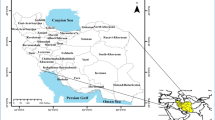Abstract
Carrying out risk assessments of agricultural drought disasters is helpful to understanding agricultural drought quantitatively and scientifically guiding drought prevention and drought relief work. In this paper, the risk assessment system and evaluation index of drought disasters are constructed, and they are composed of a drought risk subsystem, drought exposure subsystem, disaster damage sensitivity subsystem and drought resistance subsystem. Based on the grey matter-element analysis method, the agricultural drought risk evaluation model was established. Grey matter-element analysis method was used to evaluate the risk of agricultural drought in 18 regions of Henan Province, China in 2019. The results validation showed that high drought disaster risk area in Henan province is located in the western, north and the central area. This study provides a new method for the risk assessment of agricultural drought disasters. Understanding the risk in the study area can improve agricultural system resilience. This model could be used to provide support for increasing agricultural drought disaster resilience and risk management efficiency.


Similar content being viewed by others
References
Bin HE, Jianjun WU, Aifeng Lv (2010) New advances in agricultural drought risk study [J]. Prog Geogr 29(5):557–564
Chen M, Ning S, Cui Y, Jin J, Zhou Y, Wu C (2019) Quantitative assessment and diagnosis for regional agricultural drought resilience based on set pair analysis and connection entropy. Entropy 21:373
Chen M, Ning S, Jin J, Cui Y, Wu C, Zhou Y (2020) Risk assessment of agricultural drought disaster on the Huaibei plain of China based on the improved connection number and entropy information diffusion method. Water 12:1089
Cui Y, Feng P, Jin J, Liu L (2018) Water Resources carrying capacity evaluation and diagnosis based on set pair analysis and improved the entropy weight method. Entropy 20:359
Dennis N, Thomas W-G (2018) Risk analysis of seasonal agricultural drought on low Pacific Islands[J]. Agric For Meteorol 42(2):229–239
Kamali B, Abbaspour KC, Wehrli B, Yang H (2019) A quantitative analysis of socio-economic determinants influencing crop drought vulnerability in Sub-Saharan Africa. Sustainability 11:6135
Kopsiaftis G, Tigkas D, Christelis V, Vangelis H (2017) Assessment of drought impacts on semi-arid coastal aquifers of the Mediterranean[J]. J Arid Environ 137:142
Nam WH, Hayes MJ, Svoboda MD, Tadesse T, Wilhite DA (2015) Drought hazard assessment in the context of climate change for South Korea[J]. Agric Water Manag 160:106–117
Rajsekhar D, Vijay P, Singh A, Mishra K (2015) Multivariate drought index: an information theory based approach for integrated drought assessment[J]. J Hydrol 526:201–212
Shuqi L, Wensheng W, Juliang J (2019) Fuzzy set pair evaluation method for agricultural drought disaster risk and its application [J]. Hydrology. (01)
Todisco F, Mannocchi F, Vergni L (2013) Severity duration frequency curves in the mitigation of drought impact: an agricultural case study[J]. Nat Hazards 65(3):1863–1881
Wang JS, Zhang Q, Wang SP et al (2015) Characteristic analysis of drought disaster chain in southwest and south China. J Arid Meteorol 33(2):187–194 (Chinese)
Wilhelmi OV, Wilhite DA (2002) Assessing vulnerability to agricultural drought: a Nebraska case study[J]. Nat Hazards 25(1):37–58
Yamoah C-F, Walters D-T, Shapiro C-A (2013) Standardized precipitation index and nitrogen rate effects on crop yields and risk distribution in maize[J]. Agr Ecosyst Environ 8(1):113–120
Zhang J, Qiaozhen Mu, Huang J (2016) Assessing the remotely sensed drought severity index for agricultural drought monitoring and impact analysis in North China[J]. Ecol Indic 63:296–309
Acknowledgements
This work was supported in part by the Henan Provincial Key Research and Development and Promotion Special Project (soft science research) in 2021.
Author information
Authors and Affiliations
Corresponding author
Ethics declarations
Conflict of interest statement
The authors declared that they have no conflicts of interest to this work. We declare that we do not have any commercial or associative interest that represents a conflict of interest in connection with the work submitted.
Additional information
Publisher's Note
Springer Nature remains neutral with regard to jurisdictional claims in published maps and institutional affiliations.
Rights and permissions
About this article
Cite this article
Xu, H., Xu, K. & Yang, Y. Risk assessment model of agricultural drought disaster based on grey matter-element analysis theory. Nat Hazards 107, 2693–2707 (2021). https://doi.org/10.1007/s11069-021-04681-1
Received:
Accepted:
Published:
Issue Date:
DOI: https://doi.org/10.1007/s11069-021-04681-1




